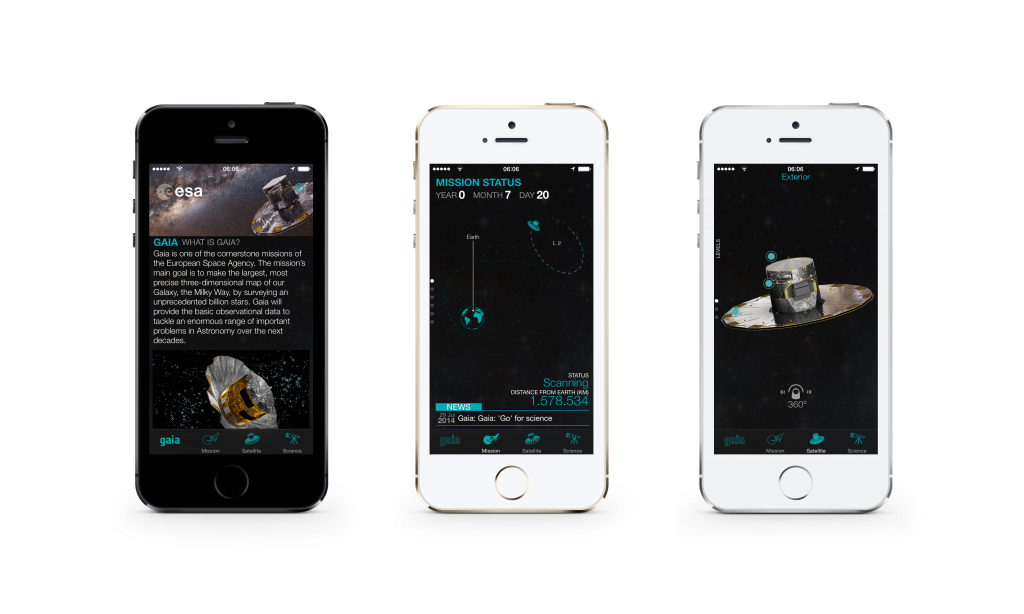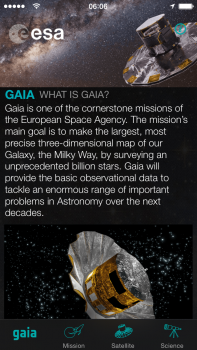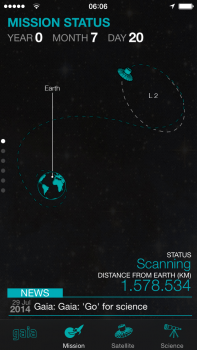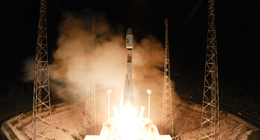Mapping one billion stars in our Galaxy may seem like an impossible feat, but that’s exactly what ESA’s Gaia mission aims to do, with the ultimate goal of creating the largest, most precise 3D map of our Galaxy ever made. And now you can follow the mission’s progress with a new app created by the University of Barcelona. Being able to track the progress of this groundbreaking mission via your iPhone, iPad or iPod means the stars have never been closer!
The Gaia Mission app is a must-have for space enthusiasts and novices alike. Beautiful images, interactive diagrams, and videos of the satellite explain many aspects of this star-mapping mission, and clear instructions and demos are available for every feature of the app. For more experienced stargazers there is a host of in-depth information available for each section, accessed by simply swiping the page.
The app has interactive diagrams of the spacecraft and payload that can be moved 360˚, letting you explore inside the Gaia satellite, and by tapping on the highlighted regions of the diagrams you’ll find clear information about each component. The trajectory of the satellite and the distance from Earth can be followed via the mission status page, and you can track how much data has been acquired and processed on the mission operations page. Live news updates will ensure that you are among the first to know about any exciting new discoveries!
This is not the first time a satellite has been sent to map the stars. Back in 1989 the ESA Hipparcos mission charted over 120,000 objects, which formed the basis of a huge stellar catalogue. The Gaia mission will greatly improve on this achievement, as it will measure the position and motion of stars with a much higher level of accuracy. The number of stars observed during this five-year mission will increase to over one billion, resulting in the most precise three-dimensional map of our Galaxy ever created. Over the course of the mission, one petabyte (one million gigabytes) of digital information will be sent to the Data Processing and Analysis Consortium for analysis and for cataloguing – that’s enough to fill over 1.5 million CD ROMs!
The Gaia satellite orbits the second Sun-Earth Lagrange point, known as L2. There, at a distance of 1.5 million kilometres from the Earth, Gaia will have excellent views of the Galaxy, free of any eclipses and in stable thermal conditions. Scanning the sky as it rotates on its axis, Gaia will view each star about 70 times, allowing a great deal of information to be collected about each and every one. The Gaia Mission app will give updates on many of Gaia’s activities, from the moment it was launched on 19 December 2013, until the final catalogue is published in 2022.
As Carme Jordi, from the team at the University of Barcelona who developed the app explains: “With Gaia, we will be able to see the entire history of the Milky Way unfolding before our eyes.”
“Gaia has so many interesting aspects – from our view of the Universe, to the life cycles of stars and the detection of exoplanets. With the app you can learn the basics of all of these things and then see how the mission builds up a new picture for us all.”
The team hopes to add more interactive features to the app over the coming months. These could also be interesting for students in second and third level education. “There are different levels within the app,” says Marcial Clotet, the engineer who first came up with the idea for the app. “Those who want to can go through the various levels and find really in-depth information to correspond to their level of interest”.
“Humans have been mapping the stars for centuries, but there is still a great deal to find out with the Gaia mission,” continues Marcial. “Many of the people who made star maps could only dream of being able to observe from space; now, not only can we do it, we can share the adventure in real time.”
The app was created by the University of Barcelona and is available for free from the iTunes store in English, Spanish and Catalan. The University of Barcelona team is now working on the Android version, which will be available later this year.
This project was co-financed by the Spanish Foundation for Science and Technology – Ministry of Economy and Competitiveness.






Discussion: 10 comments
This sounds fantastic, any chance of an Android version?
Yes! The Android version should become available later this year 🙂 Working hard to make it happen.
Any progress on the Android version? I’m envisioning being able to see a 3D representation of 1% of our galaxy… which is kind of tempting to check out…
Shall this app become a stars navigator in the future ?
For those of us still hopelessly mired in pre-smart-phone technology, are there equivalent web-based resources out there? Many of us are dying to learn more about the mission progress. Thanks!
Yes, you can follow the mission progress via our websites (Space Science Portal, Science & Technology, and Cosmos), and you can also keep in touch via Twitter (@ESAGaia)
So, any updates on Android version? 🙂
I am interesting to see the catalog..
we need to know in details regarding the distances and sizes of the spyral arms..
Looks really cool 😀
Thank you for bringing this beautiful information into out lives. Thanks to you all who help and took part, and take part still.
Kids waiting for android version of app..
Thank you all.